ISSN ONLINE(2278-8875) PRINT (2320-3765)
ISSN ONLINE(2278-8875) PRINT (2320-3765)
S Priyadharshini1, Dr.B.Meenakshi2
|
| Related article at Pubmed, Scholar Google |
Visit for more related articles at International Journal of Advanced Research in Electrical, Electronics and Instrumentation Engineering
The electric spring is an emerging technology proven to be effective in i) stabilizing smart grid with substantial penetration of intermittent renewable energy sources and ii) enabling load demand to follow power generation. The subtle change from output voltage control to input voltage control of a reactive power controller offers the electric spring new features suitable for future smart grid applications. In this project, the effects of such subtle control change are highlighted, and the use of the electric springs in reducing energy storage requirements in power grid is theoretically proven and practically demonstrated. Unlike traditional Statcom and Static Var Compensation technologies, the electric spring offers not only reactive power compensation but also automatic power variation in non-critical loads. Such an advantageous feature enables non- critical loads with embedded electric springs to be adaptive to future power grid. Consequently, the load demand can follow power generation and the energy buffer and therefore energy storage requirements can be reduced. Circuit models are developed for two bus system with and without DVR and the corresponding simulation results are presented.Index Terms— Distributed power systems, energy storage, smart grid, stability
INTRODUCTION |
| The existing control paradigm of power systems is to generate power to meet the load demand, i.e., “power generation following load demand”. With the increasing use of intermittent renewable energy sources, known or unknown to the utility companies, it is impossible to determine the instantaneous total power generation in real time. In order to achieve balance of power supply and demand, which is an essential factor for power system stability, the control paradigm for future smart grid has to be shifted to “load demand following power generation”. |
| Various load demand management methods have previously been proposed. Some examples include load scheduling, use of energy storage as a buffer, electricity pricing, direct control or on-off control of smart loads etc. |
| However, most of these methods are suitable for load demand management i n the time frame of hours and are not suitable for instantaneous energy balance in real time. Energy storage is probably the most effective means for instantaneous energy balancing. In order to cope with fast transient, energy storage elements such as battery banks are installed with parallel connected supercapacitors which can absorb current at a faster rate than chemical batteries. However, energy storage elements such as batteries are expensive and disposed batteries are major sources of pollutants. Although they are considered to be essential elements in future smart grid, it would be preferable to reduce their size for cost and environmental reasons. |
| In this project, an investigation is conducted to examine the use of electric springs in reducing energy storage elements in future smart grid. The electric spring concept was recently presented as a new smart grid technology for regulating the mains voltage of power grid with substantial intermittent renewable power and for achieving the new control paradigm of load demand following power generation. Traditional series reactive power compensators use output voltage control (Fig. 1); by shifting from the output voltage control to the input voltage control for a reactive power controller, electric springs demonstrate characteristics different from traditional devices such as series reactive power controller. The effects of this subtle change of control methodology and the interactions between the electric springs and energy storage in a power grid, which have not been previously addressed, are highlighted with practical tests in this project. Unlike Statcom, Static Var Compensation, and UPFC technologies [21]–[26], electric springs offer not only reactive power compensation, but also automatic load variation in non-critical loads (with electric springs embedded). This advantageous feature provides the possibility of reducing energy storage requirements in future smart grid. |
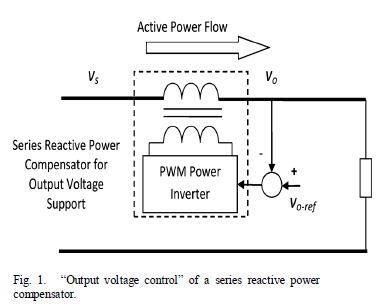 |
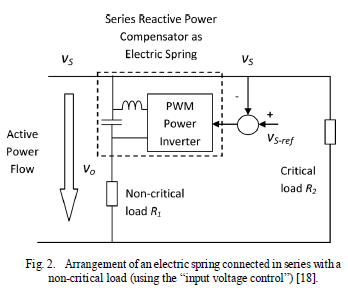 |
BASIC PRINCIPLES OF ELECTRIC SPRINGS |
| Electric springs are reactive power controllers with input voltage control instead of the traditional output voltage control used in series reactive power compensators. Details of the system operation can be found in [17]. In this session, the basic principles of electric springs are summarized so as to facilitate readers’ understanding of the power flow analysis and the effects of the electric springs on reducing energy storage requirements in smart grid. |
| Fig. 2 shows a typical installation of a single-phase electric spring connected in series with a non-critical load. The electric spring comprises a power inverter with a dc bulk capacitor on the dc side and an inductive-capacitive (LC) filter on the ac side of the power inverter. The four freewheeling diodes of the power inverter behave like a diode rectifier which rectifies the ac voltage into a dc one across the bulk capacitor. The pulse-width-modulation switching method is adopted in the power inverter to generate a controllable ac voltage across the filter capacitor. This controllable ac voltage is the output voltage of the electric spring. For pure reactive power control, the vector of the electric spring voltage and the current must be perpendicular. The input voltage control loop depicted in Fig. 2 is designed to generate dynamically with the purposed of regulating the ac mains voltage to a reference value. |
POWER ANALYSIS OF ELECTRIC SPRINGS FOR REDUCTION OF ENERGY STORAGE |
| Now consider a general power grid consisting of an ac generator, a renewable power source, energy storage (battery banks), a set of non-critical loads and a set of critical loads as shown in Fig. 3. The power flow diagram is shown in Fig.4 in which the power from the energy storage can be positive or negative depending on whether the storage device is discharging or charging. |
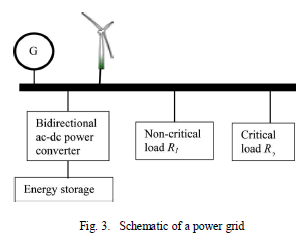 |
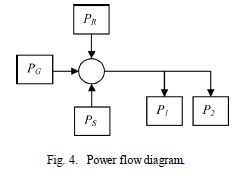 |
| Where PG is the power generated by the ac generator, PR is the renewable power, and Ps is the power from the energy st or age . Ps is positive when the battery is discharging and Negative when it is charging. |
PRACTICAL EVALUATION |
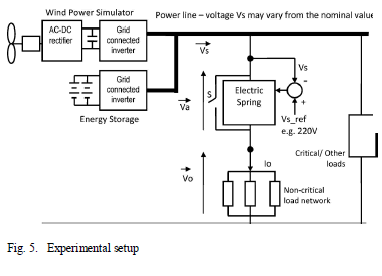 |
SIMULATION RESULTS |
| The simulation results are done with the battery system,wind system and for the hybrid system. |
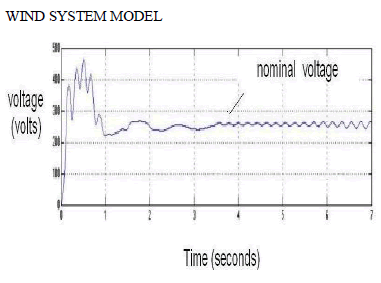 |
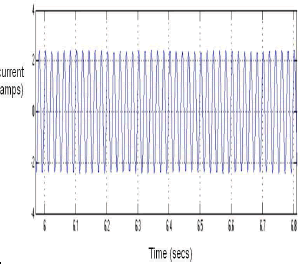 |
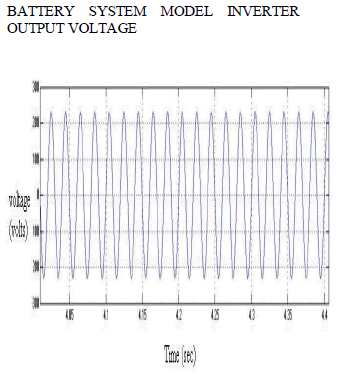 |
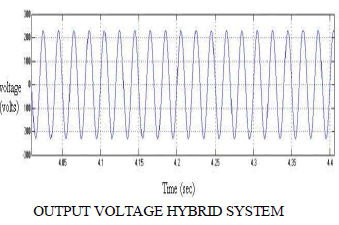 |
| The reactive power profile of the electric spring under input voltage control follows the charging and discharging time of the battery. |
| The voltage stays within 1% tolerance of 220v and the power of the critical load remains essentially constant with tight tolerance |
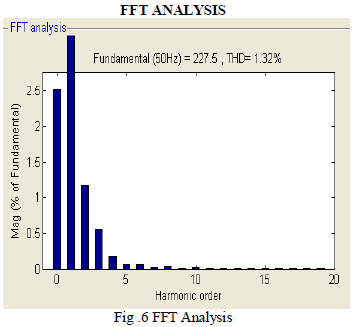 |
 |
TWO BUS SYSTEM WITHOUT DVR |
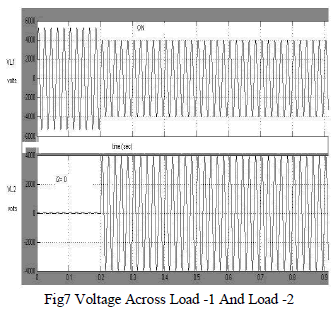 |
TWO BUS SYSTEM WITH DVR |
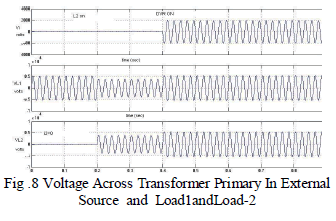 |
DVR WITHOUT LC FILTER |
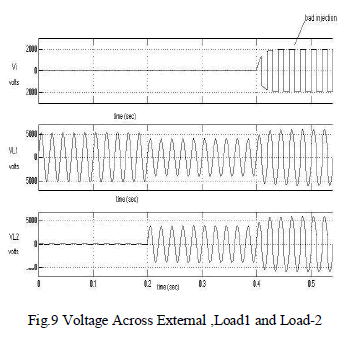 |
DVR WITH LC FILTER |
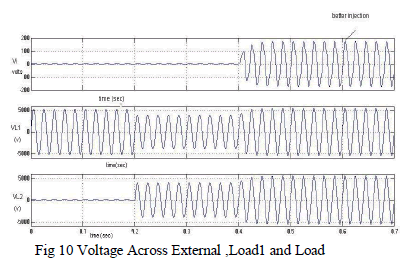 |
CONCLUSION |
| This project has presented the Simulation results of “Reduction of Energy Storage Requirements in Future Smart Grid Using Electric Springs”, showing a good agreement with the theoretical analysis. |
| The wind system, battery system and hybrid system are successfully modeled and simulated. THD is reduced by using LC filter. |
References |
|